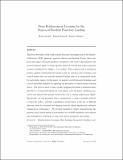Deep reinforcement learning for six degree-of-freedom planetary landing
Author(s)
Gaudet, Brian; Linares, Richard; Furfaro, Roberto
DownloadAccepted version (2.206Mb)
Publisher with Creative Commons License
Publisher with Creative Commons License
Creative Commons Attribution
Terms of use
Metadata
Show full item recordAbstract
© 2020 COSPAR This work develops a deep reinforcement learning based approach for Six Degree-of-Freedom (DOF) planetary powered descent and landing. Future Mars missions will require advanced guidance, navigation, and control algorithms for the powered descent phase to target specific surface locations and achieve pinpoint accuracy (landing error ellipse <5 m radius). This requires both a navigation system capable of estimating the lander's state in real-time and a guidance and control system that can map the estimated lander state to a commanded thrust for each lander engine. In this paper, we present a novel integrated guidance and control algorithm designed by applying the principles of reinforcement learning theory. The latter is used to learn a policy mapping the lander's estimated state directly to a commanded thrust for each engine, resulting in accurate and almost fuel-optimal trajectories over a realistic deployment ellipse. Specifically, we use proximal policy optimization, a policy gradient method, to learn the policy. Another contribution of this paper is the use of different discount rates for terminal and shaping rewards, which significantly enhances optimization performance. We present simulation results demonstrating the guidance and control system's performance in a 6-DOF simulation environment and demonstrate robustness to noise and system parameter uncertainty.
Date issued
2018-03Department
Massachusetts Institute of Technology. Department of Aeronautics and AstronauticsJournal
Advances in Space Research
Publisher
Elsevier BV
Citation
Gaudet, Brian, Linares, Richard and Furfaro, Roberto. 2018. "Deep reinforcement learning for six degree-of-freedom planetary landing." Advances in Space Research, 65 (7).
Version: Author's final manuscript